1
A Paolo
3
Abstract
This doctoral thesis is mainly focused on the development of new metal catalysts active in the polymerization of α-olefins and polar monomers from renewable sources. The attention is focused on the chemistry of Group IV metals and zinc for their low toxicity, good control of the polymerization, high thermal stability and biocompatibility. This work is divided into 5 Chapters, herein, shortly summarized.
Chapter 1 provides an overview on the chemistry of biodegradable
polyesters in term of chemical and physical properties, synthetic processes and potential applications.
Chapter 2 describes the synthesis and the characterization of new Group
IV complexes (1-5, Chart 1) bearing a tetradentate (OSSO)-type ligands (L1-3, Chart 1). The ROP of rac-lactide catalyzed by 1-5 showed a good polymerization control and high activities. In presence of hexogen alcohols, as iPrOH or tBuOH, polymerization proceeds with an “activated monomer”
mechanism alternative to the classic “coordination-insertion” process.
Chapter 3 regards the preparation and the characterization of three titanium
complexes of general formula (OSSO)TiCl2 (6-8, Chart 1) All complexes are active in ethylene and propylene polymerization in presence of MMAO or [(Ph3C)B(C6F5)4] activators; high molecular mass polyethylene (HDPE) and oligopropylene samples were obtained.
Chapter 4 reports the synthesis of a dinuclear zirconium complex bearing
4
catalytic screening in the ROP of rac-lactide, -caprolactone and β-butyrolactone, leading to the selective production of macrocyclics. The complex (9) is the first case in which the cooperative effect of the metal centers in dinuclear Group IV catalyst, yields a highly selective formation of cyclic oligomers.
Chapter 5 is aimed at introducing the copolymerizations of cyclohexene
oxide (CHO) or propylene oxide (PO) with succinic anhydride (SA) using dinuclear zinc-N-heterocyclic carbene complexes (10-12, Chart 1) under solvent free and high temperature. The catalytic performances are comparable to the most active complexes reported so far for similar reactions, producing copolymers with controlled microstructure.
5
Table of Contents
ABSTRACT ... 3 CHART 1 ... 10 CHART 2 ... 14 LIST OF ABBREVIATIONS... 16 CHAPTER 1 ... 19 INTRODUCTION ... 191.1 Sustainable Polymers from renewable resources ... 19
1.2 Polylactide (PLA) ... 21
1.3 Mechanisms of ring opening polymerization (ROP) of cyclic esters . 28 1.4 Initiators in the ROP of lactide: brief history... 32
1.5 Aim of the PhD Project ... 33
CHAPTER 2 ... 38
2.1 Group 4 Metal Complexes of the (OSSO)-type ligands as initiators in the ROP of lactide ... 38
2.2 Synthesis and characterization of the OSSO-type ligands and of the corresponding Group IV metal complexes (1-5) ... 44
2.3 Ring Opening Polymerization of rac-lactide catalyzed by 1-5 ... 57
2.3.1 Polymerization of rac-lactide in presence of isopropanol ... 62
6
CHAPTER 3 ... 74
3.1 Bis(phenolato) Group IV metal complexes in the polymerization of α-olefins ... 74
3.2 Synthesis and characterization of (OSSO)TiCl2 complexes 6-8 ... 78
3.3 Ethylene and propylene polymerization catalyzed by 6-8 ... 88
3.4 Conclusions ... 97
CHAPTER 4 ... 99
4.1 Calixarenes as alternative ligands for Group IV metal complexes ... 99
4.2 Cyclic aliphatic polyesters derived from renewable sources ... 101
4.3 ROP of rac-lactide promoted by dinuclear zirconium complex bearing a 1,5-bridged calix[8]arene ligand (9) ... 104
4.4 Kinetic studies ... 112
4.5 Polymerization of -caprolactone ( -CL) and β-butyrolactone (β-BL) ... 116
4.6 Conclusions ... 117
CHAPTER 5 ... 120
5.1 Polyesters by copolymerization of epoxides with anhydrides ... 120
5.2 Ring-opening copolymerization (ROCOP) of epoxide and anhydride ... 123
5.3 Copolymerization mechanism for epoxide and anhydride ... 129
5.4 Synthesis of dinuclear zinc-N-heterocyclic carbene complexes... 131
5.5 Copolymerization of CHO with SA catalyzed by 10-12 ... 135
5.6 Copolymerization of PO with SA catalyzed by 10-12 ... 140
7
5.8 Conclusion ... 147
CHAPTER 6: EXPERIMENTAL PART ... 150
6.1 Materials and methods ... 150
6.2 Instruments and measurements ... 150
6.3 Experimental part of Chapter 2 ... 151
6.3.1 Synthesis of 2-(bromomethyl)-4,6-bis(2-phenylpropan-2-yl)phenol ... 151
6.3.2 Synthesis of L2 ... 152
6.3.3 Synthesis of L1 ... 153
6.3.4 Synthesis of L3 ... 153
6.3.5 Synthesis of the complex 1 ... 154
6.3.6 Synthesis of the complex 2 ... 154
6.3.7 Synthesis of the complex 3 ... 155
6.3.8 Synthesis of the complex 4 ... 155
6.3.9 Synthesis of the complex 5 ... 156
6.3.10 Lactide Polymerization ... 156
6.3.11 Lactide Polymerizations in the presence of isopropanol ... 157
6.4 Experimental part of Chapter 3 ... 157
6.4.1 Synthesis of L4 ... 157
6.4.2 Synthesis of the complex 6 ... 158
6.4.2 Synthesis of the complex 7 ... 158
8
6.4.4 Procedure for Ethylene and Propylene polymerization using MMAO
... 159
6.4.5 Procedure for Ethylene and Propylene polymerization using(Ph3C)[B(C6F5)4] ... 159
6.5 Experimental part of Chapter 4 ... 160
6.5.1 Synthesis of the complex 9 ... 160
6.5.2 Ring-opening polymerization of cyclic esters ... 160
6.6 Experimental part of Chapter 5 ... 161
6.6.1 Synthesis of Zinc ethyl chloride adduct ... 161
6.6.2 Synthesis of the complex 10 ... 161
6.6.3 Synthesis of the complex 11 ... 161
6.6.4 Synthesis of the complex 12 ... 162
6.6.5 Representative Copolymerization Epoxides and Anhydride Procedure ... 162
PUBLICATIONS ON THE PhD PROJECT ... 164
OTHER PUBLICATIONS ... 164
CONTRIBUTION TO CONFERENCES ... 166
10
Chart 1
12
Complexes reported in thesis
16
List of abbreviations
Ad: Adamantyl br: broad signal
CHO: cyclohexene oxide d: doublet
DMAP: 4-Dimethylaminopyridine DSC: differential scanning calorimetry
ESI-MS: Electrospray Ionization Mass Spectrometry Et: ethyl
GPC: gel permeation chromatography I: Initiator
IMe: imidazolium salt
iPr: iso-propyl
J: coupling constant (NMR) Lact: lactate
M: Monomer m: multiplet
MALDI-MS-TOF: Matrix-assisted laser desorption/ionization time-of-flight
Me: methyl
MMAO: modified methylaluminoxane Mw: weight-average molar mass
17
NaHMDS: sodium bis(trimethylsilyl)amide
NMR spectroscopy: Nuclear magnetic resonance spectroscopy Oct: octanoate
P3HB: poly(3-hydroxybutyrate) PDI: Polydispersity index PO: propylene oxide
Pr: Probability of heterotactic enchainment PSB: polybutene succinate
rac-LA: rac-lactide
ROCOP: ring-opening copolymerization ROP: ring-opening polymerization s: singlet
SA: succinic anhydride
TBACl: tetrabutylammonium chloride
tBu: tert-butyl
TOF: turnover frequency (Mproduct/t·molcat) β-BL: β-butyrolactone
: chemical shift (NMR) -CL: -caprolactone
19
Chapter 1
INTRODUCTION
1.1 Sustainable Polymers from renewable resources
Biodegradable polymer indicates, according to IUPACdefinition, “polymer susceptible to degradation by biological activity, with the degradation accompanied by a lowering of its molar mass”.1 Factors affecting biodegradation are the polymer structure (presence of hydrolyzable linkages), polymer morphology (atactic or semicrystalline) and molecular weight.
Biodegradable polymers are natural or synthetic. The first ones (such as starch, proteins and cellulose) arise from plants and animals, while the second ones can be synthesized by homo or copolymerization of renewable monomers, obtained from the fermentation of natural carbohydrates. Polylactide is derived by the fermentation of starch, while poly(butylene succinate) is prepared from sucrose (Figure 1.1.1)2 It is possible to modulate the reaction conditions and the choice of the monomers, to obtain polyesters with fixed chemical and physical properties.
20
Biodegradable polymers are widely used in the medical field (for surgical implant devices, artificial skin and drug delivery systems), in agriculture, packaging, hazardous waste removal and in the automotive and paper industries. The growing environmental responsibility has led the government of China and Germany to encourage the use of biodegradable materials in order to reduce the volume of wastes in landfills.3 Also multinational companies, as LEGO and COCA COLA, are aiming to create products completely formed with biopolymers by 2030. A recent market study of the Nova-Institute in Germany estimated the worldwide production of biopolymers of 2% in 2020.4
21
1.2 Polylactide (PLA)
Aliphatic polyesters are an important class of biodegradable and biocompatible polymers extremely interesting in a variety of applications.5 Among these, polylactides (PLA), polycaprolactone (PCL) and polyhydroxybutyrate (PHB) are the most investigated.
PLA, discovered by Carothers in 1932, can be synthetized for polymerization of lactide, the cyclic dimer of lactic acid (Figure 1.2.1). In 1960, poly-(L)-lactide was indicated as biocompatible and biodegradable material and its copolymers (especially with glycolide) were at the basis of medical devices or other body implants. The most popular example of bio-absorbable sutures was the device provided by Vicryl, a lactide-glycolide copolymer (poly[L-LA (8%)-co-GA (92%)]).6
Figure 1.2.1. Synthesis of lactide monomer
PLA can be considered a sustainable polymer at the basis of the twelve principles of Green chemistry, well-described by Warner and Anastas in “Green Chemistry: Theory and Practice”;7 in fact, PLA is prepared from cheap raw materials and after its lifetime can be recycled by hydrolysis of the ester linkages by enzymes or using low toxic alkaline catalysts. Life cycle assessment (LCA) is an important methodology to determine environmental impacts of a process, evaluating every single stage of life cycle (Figure 1.2.2).
22 Figure 1.2.2. Life cycle of lactide polymers8
In this cycle, PLA production starts from the corn starch fermentation to obtain lactic acid, which is polymerized, under high temperature, to polymer pellets. Through injection moulding or other industrial processes, a specific product can be prepared (such as coffee cup). When the product is discarded (waste), it will be decomposed by enzymatic process. During biodegradation, the amount of CO2 produced is equal to the amount absorbed by plant for its growth.9
26
Hydrolysis and biodegradation of a polymer can be influenced by molecular weight, microstructure and macromolecular architecture that in turn depend on the reaction conditions in which this is obtained (synthesis, nature of the monomer, etc.).
Three different stereoisomers are known for LA: L-lactide (S, S), D-lactide (R,R) and meso-lactide (S, R); rac-lactide is a mixture 50:50 of L- and D-lactide (Figure 1.2.6).
Figure 1.2.6. Stereoisomers of rac-lactide
In absence of epimerization reactions, the polymerization of L- or D-lactide gives isotactic poly(L-lactide) or poly(D-lactide). From rac-lactide, three different polymers could result: 1) racemic mixture of isotactic poly(L-lactide) and poly(D-poly(L-lactide); 2) isotactic stereoblock of PLA, in which regular sequences (RR)m(SS)n or (SS)m(RR)n are present; 3) heterotactic PLA (RRSS)n. The polymerization of meso-lactide gives syndiotactic PLA.11 All possible microstructures are shown in Figure 1.2.7.
27 Figure 1.2.7. Microstructures of PLA
The physical properties depend on the tacticity of the polymer. Isotactic PLA is semicrystalline with a melting point (Tm) of 170 °C and glass transition temperature (Tg) of about 60°C; the corresponding syndiotactic polymer is characterized by a Tm of about 150 °C. Differently, the stereocomplex of PLLA and PDLA (1:1) shows a Tm of 230 °C; for the stereoblock Tm is 205°C. Finally, atactic and heterotactic PLA are amorphous and perfectly soluble in solvents as acetonitrile, toluene, chloroform and tetrahydrofuran.12
28 1.3 Mechanisms of ring opening polymerization (ROP) of cyclic esters
The lactide polymerization is an example of ring-opening polymerization (ROP). It offers many advantages in term of polymerization control, mild conditions, solvent free polymerization and possibility to achieve end-functionalization.13
Figure 1.3.1. Ring-opening polymerization of lactone and lactides.
ROP can proceed through different mechanisms, e.g. cationic, anionic, radical, coordination-insertion and activated monomer mechanism. The cationic ROP of cyclic esters is, generally, promoted by Lewis acids, protic acids and alkylating agents. The polymerization proceeds by the protonation or alkylation of a carbonyl group of lactone, which becomes positively charged. Then, the nucleophilic attack of an additional monomer breaks the O-CH bond, producing an another electrophilic carbenium ion (see Figure 1.3.2). During this process, high temperature values can induce racemization of lactide units. To minimize this undesired process, the polymerizations are carried out at about 50°C.14
29 Figure 1.3.2. Cationic ROP of lactide
The anionic ROP occurs when a nucleophilic anion of the initiator attacks the carbonyl group of the lactone, producing a cleavage of the C-O single bond. The derived alkoxide specie promotes the propagation step. (Figure 1.3.3).
Figure 1.3.3. Anionic ROP of lactide
The ring opening polymerization through the coordination-insertion mechanism is the most efficient synthetic route for the preparation of polyesters with specific properties and controlled microstructures, in terms of molecular weights, end groups and stereoregularity. The metal catalyzed ROP of LA is typically initiated by an alkoxide metal complex and the mechanism (see Figure 1.3.4) proceeds via coordination of the monomer to the metal center, followed by the attack of the alkoxide group to the activated carbonyl carbon. Successively, the intermediate undergoes acyl
30
bond cleavage to generate a new metal alkoxide species. The reaction is terminated by hydrolysis of LnM-O bond, which forms a hydroxyl end-group of the polymeric chain.15
Figure 1.3.4. “Coordination-Insertion” Polymerization
The coordination compounds can promote the ROP of lactide through an alternative route designed as “activated monomer” mechanism. In this case, the nucleophilic attack to the carbonyl group of lactone, which is preventively activated by an interation with metal complex, is carried out by an exogenous alcohol (Figure 1.3.5). This mechanism is also promoted by organocatalysts like N-heterocyclic carbenes or H-bond donors.16
31 Figure 1.3.5. Activated Monomer Mechanism
Transesterification reaction (also designated as back-biting reaction).is the main side reaction during the ROP and can be intramolecular or intermolecular. The intramolecular transesterification leads to the formation of mixture of linear and cyclic polymers, while the intermolecular process consists in achain redistribution resulting in a broadening of the molecular weight distribution (Figure 1.3.6).11
32
1.4 Initiators in the ROP of lactide: brief history
Among the large variety of complexes investigated in the ROP of lactide, the homoleptic “first generation” catalysts (SnOct2, Al(OiPr)3, Zn(Lact)2) are widely used under industrial conditions. However, they can produce undesired aggregation phenomena and subsequently promote collateral reactions (intra- or inter- molecular transesterifications), inhibiting the propagation.17 Efforts to obviate these problems were focused on the development of new heteroleptic complexes with formula LnMXm, where L represents the ligand, M is the metal center and X is an initiator group. This new family of complexes is called “second generation” and allow a better control, activity, and selectivity of the polymerization reaction.18 A large variety of metals have been tested in the ring opening polymerization of cyclic esters including examples like litium, sodium and potassium from Group 1, calcium and magnesium from Group 2, titanium, zirconium and hafnium from Group 4, aluminum and indium from Group 13 and finally rare-earth metals.19 Among these metal complexes investigated as initiators, Group 4 metal complexes have been shown to be particularly attractive thanks to their low toxicity and good control over polymerization process.20
33
1.5 Aim of the PhD Project
The PhD project is focused on the development of new metal catalysts active in the polymerization of polar monomers and α-olefins. Among the class of polydentate ligands, the attention is devoted to the tetradentate OSSO-type bis(phenolato) ligands for their easy preparation and high affinity to Group IV metals. The group IV alcoholates are known as powerful initiators in the ROP of cyclic esters (rac-lactide, -caprolactone and β-butyrolactone). The influence of steric and electronic properties of the ligand will be investigated using three different OSSO-type ligands substituted by tert-butyl, cumyl and chlorine atoms (L1-4, Chart 1) and the corresponding Group IV metal complexes of general formula (OSSO)M(OR)2
which are tested in the polymerization of rac-lactide (Figure 1.5.1).
Figure 1.5.1. (OSSO)M(OR)2 tested in the ROP of rac-lactide
(OSSO)-type bis(phenolato) complexes are a versatile class of catalysts, as matter of fact the corresponding chloro derivates have been found active in the polymerization of α-olefins. The catalytic performances of the chloro complexes of general formula (OSSO)TiCl2 will be investigated in the polymerization of ethylene
34 Figure 1.5.2. (OSSO)MCl2 for ethylene and propylene polymerization
Although mononuclear Group IV metal complexes are widely explored in the ROP of lactones, few examples of corresponding dinuclear complexes have been studied until now. As part of our interest in developing Group IV metal catalysts for the ROP of cyclic esters, we turned focus on the zirconium calixarene complex. In particular, we explored the synthesis of a di-zirconium complex 9 featuring p-tert-butylcalix[8]arene 1,5-bridged with m-xylene diyl functionality and its use in the ROP of rac-lactide, -caprolactone and β-butyrolactone.
35 An alternative approach to prepare biodegradable and biocompatible polyesters consists in the ring opening copolymerization (ROCOP) of cyclic anhydrides with epoxides. This reaction allows to modulate the physical and chemical properties of the desired polyester, choosing appropriately the substituents on the monomers. Among the most active catalysts, there are dinuclear zinc complexes that are interesting for their high control of polymerization and activity.21 For these
fascinating advantages, we plan to synthetize a new class of dinuclear zinc complexes bearing a monodentate N-heterocyclic carbene ligands (10-12, Chart 1) for catalytic screening in the copolymerization between succinic anhydride (SA) and propylene oxide (PO) or cyclohexene oxide (CHO).
36
1.6 References
1 PAC, 2004, 76, 889; doi:10.1351/pac200476040889.
2 Zhu, Y.; Romain, C.; Williams, C. K. Nature, 2016, 540, 354-362. 3 Kumar, A. A.; Karthick. K, and Arumugam, K. P. International Journal of Bioscience, Biochemistry and Bioinformatics, 2011, 1, 173-176.
4http://biovalue.dk/bioplastic-seminar-2016/
5 a) Middleton, J. C.; Tipton, A. J. Biomaterials 2000, 21, 2335−2346. b) Nair, L. S.; Laurencin, C. T. Prog. Polym. Sci. 2007, 32, 762−798. c) Ikada, Y.; Tsuji, H. Macromol. Rapid Commun. 2000, 21, 117−132.
6 a) Lewis D. H. Biodegradable polymers as drug delivery systems, 1990, 1-41; b) Albertsson, A.-C.; Varma, I. K. Degradable Aliphatic Polyesters, 1-40.
7 Anastas, P. T.; Warner, J. C.; Green Chemistry: Theory and Practice, Oxford University Press, New York, USA, 1998.
8 From http://www.technologystudent.com/pdf7/poly2.pdf
9 Buggy, M. Natural Fibres, Biopolymers, and Biocomposites (Eds. Mohanty, A.; Misra, M.; Drzal, L.) CRC Press, Taylor & Francis Group,
New York, 2005.
10 de Andrade, M. F. C.; Souza, P. M. S.; Cavalett, O.; Morales, A. R. J Polym Environ. 2016, 24, 372-384.
11 Dechy-Cabaret, O.; Martin-Vaca, B.; Bourissou, D. Chem. Rev. 2004, 104, 6147-6176.
12 Kricheldorf, H. Chemosphere 2001, 43, 49-54. 13 Tong, R. Ind. Eng. Chem. Res. 2017, 56, 4207–4219.
14 a) Duda, A.; Penczek, S. Thermodynamics, kinetics and mechanisms of cyclic esters polymerisation. In Polymers from Renewable Resources: Biopolyesters and Biocatalysis; Scholz, C.; Gross, R. A., Eds.; ACS
37 Symposium Series; Oxford University Press: Washington, DC, 1996; Vol.
5, 317-343. b) Tang, Z.; Chen, X.; Liang, Q.; Bian, X.; Yang, L.; Piao, L.; Jing, X. J Polym Sci Part A Polym Chem 2003; 41,1934–1941.
15 Platel, R. H; Hodgson, L. M.; Williams, C. K. Polymer Reviews 2008, 48, 11-63.
16 a) Ajella, N.; Carpentier, J.-F.; Guillaume, C.; Guillaume, S. M.; Helou, M.; Poirier, V.; Sarazin, Y.; Trifonov, A. A. Dalton Trans., 2010, 39, 8363-8376. b) Sarazin, Y.; Poirier, V.; Roisnel, T.; Carpentier, J.-F. Eur. J. Inorg.
Chem., 2010, 3423-3428. c) Sarazin, Y.; Liu, B.; Roisnel, T.; Maron, L.;
Carpentier, J.-F. J.A.C.S., 2011, 133, 9069-9087.
17 a) Degee, P.; Dubois, P.; Jerome, R.; Jacobsen, S.; Fritz, H.-G. Macromol. Symp. 1999, 144, 289; b) Duda, A.; Penczek, S. Macromolecules 1998, 31,
2114. c) Chabot, F.; Vert, M.; Chapelle, S.; Granger, P. Polymer 1983, 24, 53. d) Schwach, G.; Coudane, J.; Engel, R.; Vert, M. Polym. Int. 1998, 46, 177.
18 Thomas, C. M. Chem. Soc. Rev., 2010, 39, 165–173.
19 a) Yang, X.; Wang, L.; Yao, L.; Zhang, J.; Tang, N.; Wang, C.; Wu, J. Inorg. Chem. Commun. 2011, 14, 1711−1714. b) Dutta, S.; Hung, W. C.;
Huang, B. H.; Lin, C. C. Adv. Polym. Sci. 2012, 245, 219. c) Chuck, C. J.; Davidson, M. G.; du Sart, G. G.; Ivanova-Mitseva, P. K.; Kociok-Kohn, G. I.; Manton, L. B. Inorg.Chem., 2013, 52, 10804-10811.
20 a) Sauer, A.; Kapelski, A.; Fliedel, C.; Dagorne, S.; Kol, M.; Okuda, J. Dalton Trans. 2013, 42, 9007–9023. b) Della Monica, F.; Luciano, E.;
Roviello, G.; Grassi, A.; Milione, S.; Capacchione, C. Macromolecules
2014, 47, 2830-2841.
21 a) Wu, L.-y.; Fan, D.-d.; Lu, X.-q.; Lu, R. Chin. J. Polym. Sci. 2014, 32, 768−777. b) Saini, P. K.; Romain, C.; Zhu, Y.; Williams, C. K. Polym.
39
Group IV metal complexes of salan-type (see Chart 2) ligand showed a high activity in the ROP of lactide, producing isotactic enriched PLA (Figure 2.1.2).22
Figure 2.1.2. Group 4 complexes bearing salan ligands
Chakraborty et al. observed that polynuclear complexes of zirconium and hafnium bearing salen-type ligand (see Chart 2) promoted fast polymerization of rac-lactide under solvent-free conditions (200 eq. converted in 60 min), producing polymer with a molecular weight of 30 KDa (Figure 2.1.3).
40
In 2010 Mahon prepared of a series of unsymmetrical Group IV salalen (Chart 2) complexes active in the ROP of lactide (Figure 2.1.4).
Figure 2.1.4. Group IV salalen complexes.24
These complexes converted 300 equivalents of rac-lactide in 15 min under bulk condition, and in 2 h in toluene solution. Unexpectedly, the analogous hafnium catalyst displayed lower activity (98 % conv. in 24 h, toluene); the resulting PLA is isotactic.
Titanium and zirconium complexes of phenylenediamine bis(phenolato) ligand (Figure 2.1.5) displayed extremely high activity in lactide polymerization. The titanium complex converted 300 eq. of rac-lactide into 2 min, yielding heterotactic PLA;the heteroselective polymerization may result from the fluxional character of the catalysts in solution.
41
Recently, Kol et al. have introduced another class of Group IV complexes with ONSO-type ligands; they are similar in the structure to the ONNO-type ligand, but the rigid imine link is replaced by a more flexible thioether linkage. The reaction of the protonated ligand with Zr(tBuO)
4 gave (ONSO)Zr(OtBu)
2 complexes, which are active in the polymerization of L-lactide and rac-L-lactide. The poly-rac-L-lactide obtained using this fluxional catalyst are heterotactic enrichment, whereas the polymer prepared by the rigid catalyst is prevalently isotactic (Figure 2.1.6).
Figure 2.1.6. Zirconium Complexes of (ONSO) Ligands26
Finally, in 2010, Kol reported the first examples of syndiotactic PLA from
meso-lactide using (OSSO)-type titanium complexes and heterotactic
poly(meso-lactide) using similar zirconium complexes; the schematic representation of the catalysts is reported in Figure 2.1.7.
42 Figure 2.1.7. Group 4 Complexes bearing dithiodiolate ligands27
The major contribution in the chemistry of Group IV complexes supported by OSSO-type bis(phenolato) was given by Okuda who described the synthesis of new zirconium catalysts based on 1,ω-dithia-alkanediyl-bridged bis(phenolato) (OSSO)-type ligands extremely active in the polymerization of meso-lactide to give heterotactic polylactides (Figure 2.1.8).
43
In an effort to further study the catalyst activity and structure-selectivity correlations in the ROP of rac-lactide, we prepared a new series of Group IV complexes bearing o-phenylene-bridged bis(phenolato) ligands of general formula (OSSOX)M(OR)2 (1-5), in detail, studied in the Section 2.2.29
44
2.2 Synthesis and characterization of the OSSO-type ligands and of the corresponding Group IV metal complexes (1-5)
The o-phenylene-bridged bis(phenolato) ligands were synthesized by reaction between benzene-1,dithiol and 2 equivalents of 2-(bromomethyl)phenol in dry THF (Scheme 2.2.1).30
Scheme 2.2.1. Synthetic Route for the OSSO-type (bispenolato) ligands used for the preparation of complexes 1-5
To explore the influence of electronic and steric parameters of the ligands, we prepared three different ligands substituted by tert-butyl or cumyl groups and chlorine atoms (L1-3, Scheme 2.2.1); the ligands were obtained as white solids in good yields (50-80%). L1 and L2 were purified by recrystallization from petroleum ether at room temperature. L3 is poorly soluble in petroleum ether or n-hexane at room temperature and was purified by crystallization from cold toluene. All the ligands were fully characterized by NMR spectroscopy and elemental analysis. The
45
assignments of the resonances were based on previously reported data. In all the spectra, the signal of the methylene groups appears as a sharp singlet in the range 3.96- 4.13 ppm (CDCl3, rt, Figure 2.2.1). In detail, the 1H NMR spectrum of L1 displays at 1.21 and 1.41 ppm two singlets corresponding to 36 protons assuming the tert-butoxide groups as internal standard. The signal of the methylene groups (s, 4 H, 4.13 ppm) are followed by the singlet of hydroxide groups (2 H) at 6.09 ppm. The aromatic protons (8H) are detected in the range between 6.85-7.36 ppm. It is worth noting that in the 1H NMR spectrum of the L2, the methyl groups of the two different cumyl substituents give rise to a single signal.
46 Figure 2.2.1. 1H NMR spectra of L1-3 (CDCl3, 300 MHz, 25°C).
47
Recrystallization of L2 from toluene/THF afforded crystals suitable for X-ray analysis. The X-X-ray molecular structure is shown in Figure 2.2.2, in which one thiophenoxo unit is depicted in purple for sake of clarity (thermal ellipsoids at the 30% probability level). The bond lengths and angles are in the range observed for similar OSSO-type ligands reported in literature30.
Figure 2.2.2. Molecular structure of OSSOCum-H resolved by single-crystal X-ray diffraction
The corresponding group 4 metal complexes of general formula (OSSOX)M(OR)2 (X = R = tBu, M = Zr (1); X = cumyl, R = tBu, M = Zr (2); X = cumyl, R = iPr, M = Ti (4); X = cumyl, R = tBu, M = Hf (5)) were
prepared by reaction of the proligand with the appropriate homoleptic metal precursor (Zr(OtBu)4, Hf(OtBu)4 and Ti(OiPr)4) in toluene at 25°C (Scheme 2.2.2).The crude products were washed with n-hexane and isolated as pale yellow solids in good yields (65-70 %). The 1H NMR monitoring of the reaction displayed a complete evolution of the reagents into the desired complexes in few minutes.
48 Scheme 2.2.2. Synthesis of heteroleptic Group IV metal complexes
Except for L3, the heteroleptic complexes (OSSOX)M(OR)2 were obtained in pure form. Surprisingly, the reaction of L3 with Zr(OtBu)
4 led to the homoleptic complex (OSSOCl)2Zr (3) regardless of the [ligand]/[Zr] molar ratio and the experimental conditions (temperature, solvent, order of addition of the reagents used), likely as result of the high acidity of the ligand and low steric encumbrance offered by chloro substituents (Scheme 2.2.3). The homoleptic complex 3 was isolated as pure solid after the direct reaction of Zr(OtBu)4 with 2 equivalents of the proligand in toluene solution
49 Scheme 2.2.3. Synthesis of (OSSOCl)2Zr complex
Figure 2.2.3. 1H NMR spectrum of (OSSO
Cl)2Zr (3) (Tol-d8, 600 MHz, 25°C).
In principle the tetradentate OSSO-type ligands can wrap the Group IV metal center in an octahedral environment producing three different stereoisomers, named as mer–mer (trans), fac–fac α) or fac–mer (cis-β), showing CS, C2 and C1 symmetry, respectively. The cis-α and cis-β
51 Figure 2.2.5. 1H NMR of (OSSO
tBu)Zr(OtBu)2 (1) (600 MHz, C6D6, 25°C)
In order to explore the configurationally stability of complex 1, the 1H NMR spectrum was acquired in the range from 20°C to 100°C. The variable temperature 1H NMR (VT-NMR) spectra are reported Figure 2.2.6. The configuration of complex 1 resulted highly stable; as matter of fact, coalescence of the resonances resulting from a fast enantiomer (Δ - Λ) interconversion was not observed in the explored range of temperature. It is worth noting that the analogous OSSO zirconium complex is rigid at room temperature and become fluxional upon warming; the coalescence of the diastereotopic protons is observed at 85°C. 31
53
The 1H NMR spectrum of 3 indicates a highly symmetric structure, in which the methylene protons resulted in the AB pattern and one of the two doublets are downfield shifted at 5.59 ppm (Figure 2.2.7).
Figure 2.2.7. 1H-1H EXSY spectrum of 3(C
6D6, 60°C, mixing time 0.400 s, 600 MHz)
Differently, the 1H NMR spectrum of (OSSO
Cum)Ti(OiPr)2 (4) revealed, already at room temperature, fast fluxional behavior producing a broad singlet at 3.62 ppm for the S-CH2 protons. The smaller size of titanium atom and the weaker interaction between the soft sulfur atom and the hard titanium ion likely influenced the configurational rigidity of 4 (Figure 2.2.8).
The solution structure of (OSSOCum)Ti(OiPr)2 complex (4) was also monitored by variable temperature NMR in the range between -40°C to
54
30°C in CD2Cl2. The broad resonance of the S-CH2 groups resolved in the typical AB pattern, after the coalescence at 0°C. The isopropoxide groups produced a doublet at 1.06 ppm and a septet at 4.38 ppm. The signals relative to the aromatic protons were observed in the range 6.03 - 7.40 ppm.
Figure 2.2.8. 1H NMR of (OSSO
Cum)Ti(OiPr)2 (4) (600 MHz, Tol-d8, 25°C)
Kinetic parameters were calculated using line-shape analysis of the 1H NMR spectra measured in the temperature range from -40 to 30 °C. The free energy of activation for the fluxional processes was calculated as ΔG⧧ = 13.4 ± 0.1 kcal mol−1 at 293 K. The activation parameters were ΔH⧧ = 11.9 ± 0.3 kcal mol−1and ΔS⧧= −5 ± 1 cal mol−1 K−1.
56
The X-ray analysis of the complex (OSSOCum)Zr(OtBu)2(2) confirmed the C2-symmetric structure, in which the zirconium center is in octahedral environment resulting from the fac-fac coordination of the tetradentate ligand (Table 2.2.1). The bond length Zr-S (2.87 Å) are longer than the typical bond observed in this class of complexes with a consequent steric congestion around the Zr atom. Moreover, the distances of Zr- alkoxy groups (1.92Å) and Zr-O1 (2.03 Å) were paragonable to the analogous complexes of this family reported in literature.31
Figure 2.2.10. ORTEP drawing of (OSSOCum)Zr(OtBu)2
Selected bond lengths (Å) and bond angles (°) Zr−S1 2.8704 (5) Zr−S2 2.8797 (5) Zr−O1 2.0309 (14) Zr−O2 2.0380 (14) Zr−O3 1.9263 (14) Zr−O4 1.9420 (15) S1−Zr1−S2 70.928 (18)
Table 2.2.1.Selected bond lengths (Å) and bond angles (°) for (OSSOCum)Zr(OtBu)2 as determined by single-crystal X-ray diffraction.
57
2.3 Ring Opening Polymerization of rac-Lactide catalyzed by 1-5
The complexes 1-5 were tested in the polymerization of rac-lactide in toluene (2.4 mL) at 100°C using the initiator to monomer molar ratio of 100.
Figure 2.3.1. ROP of lactide catalyzed by 1-5
The main results are reported in the Table 2.3.1. At specified time intervals, a small amount of the polymerization mixture was sampled by a pipette and quenched in wet CDCl3 to evaluate the conversion through 1H NMR spectroscopy.
Table 2.3.1. ROP of rac-lactide catalyzed by 1-5
aAll reactions were carried out in 2.4 mL of toluene; [I]
0 = 5.0 mM, [LA] = 0.52 M, [LA]/[I]0 = 100, and T = 100 °C. bMolecular conversion determined by 1H NMR spectroscopy (CDCl3, 298 K). cTOF = molLA/(molI h). dCalculated molecular weight using Mn(th) (kg mol−1) = (144.13×([LA]0/[I]0)×(LA conversion))/1000. eExperimental molecular weight Mn(expt) (kg mol−1) and polydispersity (PDI) determined by GPC in THF using polystyrene standards and corrected using the factor 0.58. fMn(th) (kg mol−1) = (144.13 × ([LA]
0/[2 × I]0)×(LA conversion))/1000.
Entrya Initiator t/h Conv.%b TOF/h-1c M
n(th)d Mn(expt)e PDIe 1 1 24 88 3.7 12.7 14.0 1.12 2 2 24 96 4.0 13.8 17.1 1.12 3 3 24 0 - - - - 4 4 72 90 1.3 6.5f 6.3 1.13 5 5 24 94 3.9 13.5 15.4 1.32
58
Complexes 1 and 2 showed a moderate activity, leading to high monomer conversion in 24 h; the turnover frequencies (TOF) are of 3.7 and 4.0 h-1, respectively. The complex 3 was inactive, differently by similar homoleptic group IV metal complexes reported in literature20 that are effective initiators for the ROP of lactide. Changing the metal center from zirconium (2) to hafnium (5), the catalytic performances were not influenced, obtaining high monomer conversion in 1 day. As expected, 4 was less active than the corresponding zirconium complexes 1 and 2, leading to 90 % conversion in 72 h.
To investigate the mechanism of polymerization, 2 was selected for the kinetic investigations, via 1H NMR spectroscopic analysis. At 100°C, the polymerization reaction displayed an induction period of 6 h after which the polymerization proceeded with a first-order dependence with respect to the monomer concentration. The semilogarithmic plot of ln([rac-LA]0 /[rac-LA]t) versus time (h) was linear with a slope of 0.147 ± 0.008 h-1. At 80°C, the catalytic activity decreased and a longer induction time was observed, as reported in Figure 2.3.2. In this last case, kobs was of 0.0371 ± 0.0009 h−1.
Figure 2.3.2. Kinetic of rac-LA polymerization by 2 at 100 C (●) and 80 C (▲). (kobs (100 °C) = 0.147 ± 0.008 h−1 R2 = 0.986; k
59
The origin of this induction time can be related to the genesis of the catalytic species. To identify the active species in the polymerization process, the reaction of 2 with rac-LA was monitored by 1H NMR spectroscopy. The intensity of the signals of 2 decreased producing new patterns of proton signals, but it was not possible to identify the products in the reaction mixture.
The PLA samples by 2 showed narrow distributions of molecular weight (1.12 ≤ PDI ≤ 1.32) and a good agreements between the experimental and theoretical Mn values were observed in all samples by zirconium and hafnium catalysts. As reported in Figure 2.3.3, the experimental Mns increase linearly with the monomer conversion. The polymers, obtained by titanium complex 4, displayed experimental molecular weights in agreement with the corresponding theorical Mns, assuming the growth of two chains per metal center. The PLAs obtained by 1-5 were atactic.
Figure 2.3.3. Plot of number-averaged molecular weights Mn(expt) (dot) vs conversion (%) with theoretical Mn(th) (dash line) using 2 as an initiator at 100 °C, Mw/Mn values are in parentheses. 0 20 40 60 80 0 5 10 (1.11) (1.08) (1.12) (1.10) (1.10) Mn (kDa) Conversion (%)
60
Finally, the obtained PLAs were characterized by NMR spectroscopy and ESI mass spectrometry. The 1H NMR spectrum of the sample by 2, in CDCl3, showed the signals relative to the tert-butoxide end groupat 1.46 ppm, indicating a coordination-insertion mechanism (Figure 2.3.4). ESI MS analysis displayed a peak distribution relative to oligomers end terminated with tert-butoxide and hydroxyl groups [OCH(CH3)C(=O)]n-OtBu, in agreement with the NMR data. A second series of peaks was also detected due to the presence of cyclic oligomers. Both distributions were characterized by peaks separated by m/z of 72 corresponding to half monomer unit for effect of intramolecular and intermolecular transesterifications.
Figure 2.3.4. 1H NMR spectrum of PLA by 2 (CDCl
62
2.3.1 Polymerization of rac-lactide in presence of isopropanol
The addition of an exogenous alcohol (ROH) has a benefical effect on the performances of the catalyst.16 During the ring opening polymerization process, in absence of ROH, the number of growing polymer chain is equal to the number of the active sites, possibly the number of metal atoms of the precatalyst. The introduction of a nucleophilic species, as an alcohol (ROH), results in chain transfer between growing and dormant macromolecules. The number of growing polymer chains is, in this case, equal to ROH and higher than the metal atoms; this process is known as “immortal ROP” (Scheme 2.3.1.1).
Scheme 2.3.1.1. Schamatic representation of ROP in presence of ROH
Recently, Carpentier reviewed the ROP of cyclic esters using cationic complexes in presence of exogen alcohols.32 The cationic complexes were classified in three different categories named type-I, type-II and type-III. Type-I indicates metal complexes bearing nucleophilic ancillary ligand that are reactive toward the incoming cyclic monomer; type-II represents complexes with the nucleophilic groups inert toward the monomer and type-III where there is no nucleophile. The polymerization promoted by type-I complexes lead to only one growing chain per metal atom and the chain length is defined by the [monomer]converted/[number of catalyst]0 ratio (m/n) (Figure 2.4.1, left). In presence of one molecule of type-I or type-II complex and an excess of alcohol, the number of growing polymer chain is equal to
63
the molecules of alcohol and the chain length is dipendent of [monomer]converted/[protic nucleophile]0 ratio (m/p). A fast transfer between growing and dormant macromolecules induce changing on the chain length defined as m/(p+1). The overell process is reported in Figure 2.3.1.2.
Figure 2.3.1.2 Living and Immortal ROP Processes32
To improve the performances of the complexes 1-5, iPrOH (5 equiv.) was
64 Table 2.3.1.1. ROP of rac-lactide in presence of exogenous alcohol
aAll reactions were carried out in 2.4 mL of toluene, [I]
0 = 5.0 mM, [LA] = 0.52 M, [ROH]= 25.0 mM; [LA]0:[I]0:[ROH]0 = 100:1:5. bMolecular conversion determined by 1H NMR spectroscopy (CDCl3, 298K). cCalculated molecular weight using Mn(th) (Kg mol−1) = (144.13 × ([LA]0/[ROH]0) × LA-conversion)/1000. dExperimental molecular weight Mn(expt) (Kg mol−1) and polydispersity (PDI) determined by GPC in THF using polystyrene standards and corrected using the factor 0.58. eProbability of racemic linkages as determined by homodecoupled 1H NMR spectroscopy.
At 100°C, 1 converted 100 equivalents of monomer in 5 hours, whereas 2 showed high monomer conversion in only 30 min (TOF = 1.9 x 102 h-1). The complex 5 consumed 95 mol % of rac-lactide in 0.5 h and the titanium complex 4 allowed 92 mol % conversion in about 2 h. In presence of isopropanol, 3 became active in the ROP of lactide. The PLAs produced by
1-5 are atactic. The polymerization promoted by complex 2 in presence of
isopropanol was monitored at 80°C through 1H NMR spectroscopy, observing a first-order kinetics with an apparent rate constant of 2.32±0.05 h-1. The good agreement between the theoretical and experimental molecular weigths, calculated considering the growing of one chain for molecule of isopropanol, indicated an efficient control of the polymerization process. All the polymers exhibit a monomodal distribution of the molecular weigth with the PDI values in the range of 1.1-1.2 (Figure 2.3.1.3).
Entrya Initiator Temp. alcohol t/h Conv.%b TOF/h-1c Mn(th)d M
n(expt)e PDIe Prf 1 1 100 iPrOH 5 80 1.6 x 101 2.3 3.8 1.10 0.51 2 2 100 iPrOH 0.5 94 1.9 x 102 2.7 2.3 1.16 0.55 3 2 80 iPrOH 1.5 97 6.5 x 101 2.8 1.9 1.10 0.56 4 2 50 iPrOH 45 71 1.6 2.0 2.2 1.10 0.57 5 3 100 iPrOH 24 72 3.0 2.2 2.2 1.19 0.57 6 4 100 iPrOH 2 92 4.6 x 101 2.6 1.3 1.11 0.52 7 5 100 iPrOH 0.5 95 1.9 x 102 2.7 1.8 1.20 0.58 8 2 100 tBuOH 0.17 95 5.6 x 102 2.7 4.8 1.21 0.58 9 2 80 tBuOH 0.33 94 2.8 x 102 2.7 3.8 1.10 0.66 10 2 50 tBuOH 24 95 4.0 2.7 4.7 1.09 0.66
65 Figure 2.3.1.3 (up) Kinetic of rac-LA polymerization promoted by catalyst 2/iPrOH. (down) Plot of number-averaged molecular weights Mn(expt) (dot) vs monomer conversion (%) with theoretical Mn(th) (dash line) using the catalyst 2/iPrOH,
The 1H NMR spectrum of PLA displays a polymer chain terminated with isopropoxide (CH at 4.35 ppm as heptet and CH3 at 1.69 ppm as doublet)
and hydroxide end groups (Figure 2.3.1.4). The ESI MS spectrum confirmed the existence of linear oligomers with –OiPr end-groups (Figure 2.3.1.5). 0 20 40 60 80 0 1 2 3 ln ([LA ]0 /[LA ] t ) time (min) 0 20 40 60 80 0,0 0,5 1,0 1,5 2,0 (1.08) (1.10) (1.10) (1.09) (1.06) Mn (kDa) Conversion (%)
67
Different monomer/initiator molar ratios were explored to test the living character of complex 2 in presence of 5 equiv. of iPrOH. In the range from
100 to 1000, the experimental molecular weights increase linearly as expected for the theoretical values; the distribution of Mns are monomodal and the PDI values are in the range 1.1-1.2 (Figure 2.3.1.6).
2.3.1.6. Plot of Mn(expt) (dot) vs Mn(th) (dash line) using 2/iPrOH.
With the aim to investigate the polymerization mechanism, the reaction of the catalyst (OSSO)tBuZr(OtBu)2 (1) with isopropanol was monitored by 1H NMR spectroscopy in NMR tube, using benzene-d6 at 25°C. The NMR spectrum displayed a quantitative conversion of 1 into the corresponding isopropoxide derivate [(OSSO)tBuZr(OiPr)2] with the concomitant production of tBuOH (Figure 2.3.1.7).
0 200 400 600 800 1000 0 5 10 15 20 (1.19) (1.14) (1.14) (1.13) (1.11) Mn (kDa) [LA]/[I]
68 Figure 2.3.1.7 Scheme of exchange reaction between 1 and iPrOH.
The strong increase of reactivity can not be due only to the change of initiator group. Therefore, to evaluate the effective role of external alcohol, the ROP of rac-lactide (100 eq.) was carried out using the complex 2 in presence of tBuOH as cocatalysts, see Table 2.3.1.1 (entries 8-10); at 100°C
high monomer conversion was observed in 10 min. The kinetics was of first-order with respect to the monomer concentration and the measured rate costant was 7.8±1.2 h-1 (Figure 2.3.1.8).
69 Figure 2.3.1.8. Kinetic plot for ROP of rac-LA promoted by 1 at 80°C in absence of alcohol
(up) with kobs = 0.371±0.0009 h-1 and in presence of tBuOH (down) with kobs = 7.8±1.24 h-1 0 1 2 3 0 20 40 60 80 ln [r ac -LA] 0 /[[ra c-LA] t time (h) 0 1 2 0 5 10 15 20 ln [r ac -LA] 0 /[ra c-LA] t time (min)
70
The 1H NMR and ESI MS analysis of the obtained PLA confirmed the formation of linear oligomers characterized by tert-butoxide end groups (singlet at 1.46 ppm), below Figure 2.3.1.9 and 2.3.1.10.
Figure 2.3.1.9. 1H NMR spectrum (400 MHz, CDCl
3, 298 K) of PLA by 2/tBuOH
71
As in the case of iPrOH, the reaction of 1 with tBuOH was investigated
through 2D 1H−1H EXSY spectroscopy. An exchange reaction between tert-butyl alcohol and the tert-butoxy ligand was detected; the process was
slow with the rate constant of 1.0× 10-3 s-1.
All the experimental evidences suggest the establishment of an alternative ROP focused on the “activated monomer” mechanism. This process implies, firstly, the coordination of the lactide to the Lewis acidic metal center that actives the monomer, then the nucleophilic attack of ROH to the electrophilic carbon atom of the carbonyl group triggers the polymerization process (Figure 2.3.1.11).
72
2.4 Conclusions
We synthetized a new series of (OSSO)-type Group IV complexes of general formula (OSSOX)M(OR)2, by protonolysis reactions between an appropriate proligand (L1-3) and a metal alkoxide precursor. All complexes were obtained in good yields and fully characterized by NMR spectroscopy. 1H NMR of the complexes suggested an octahedral environment with rigid C2-symmetry as confirmed by crystallographic data of complex 2 (Figure
2.2.10), in which the fac-fac ligand wrapping around the metal center was observed. The titanium complex 4 showed a fluxional character at 25°C because of weaker interaction between the soft sulfur atom and the hard titanium ion. Complexes 1-5 were active in the ROP of rac-lactide; the best performance was observed with 2, where the monomer was quantitatively converted into polymer in 24 h. The polymerization is characterized by long induction time and a pseudo first order kinetic with respect to the monomer. In the presence of iPrOH, the catalytic performances improved (94 %
conversion, 30 minutes) and no induction time was registered. Under this condition, a linear dipendence between molecular weight and monomer conversion was observed, suggesting a living character of the polymerization. The strong increase of the polymerization reactivity can not justified only by the exchange of the initiator group. The ROP by 2 was studied in presence of 5 eq. of tBuOH; a 95 % of monomer conversion in 30
minutes was observed and the resulting polymer showed a tert-butoxide end group. 1H-1H EXSY experiment displayed the stability of the complex 2 in presence of tert-butanol. The lack of reactivity of 1-5 in presence of an exogenous alcohol, suggests that the ROP operating mechanism is the activated monomer mechanism in alternative to the common coordination-insertion process.
73
2.6 References
22 Bradley, D. C.; Mehrotra, R. C.; Rothwell, I. P.; Singh, A. Alkoxo and Aryloxo Derivatives of Metals, Academic, San Diego, CA, 2001.
23 Saha, T. K.; Ramkumar, V.; Chakraborty, D. Inorg. Chem. 2011, 50, 2720-2722.
24 Whitelaw, E. L.; Jones, M. D.; Mahon, M. F. Inorg. Chem. 2010, 49, 7176–7181
25 Zelikoff, A. L.; Kopilov, J.; Goldberg, I.; Geoffrey W. Coates, G. W.; Kol, M. Chem. Commun., 2009, 6804-6806.
26 Stopper, A.; Press, K.; Okuda, J.; Goldberg, I.; Kol, M. Inorg. Chem.
2014, 53, 9140−9150.
27 Sergeeva, E.; Kopilov, J.; Goldberg, I.; Kol, M. Inorg. Chem., 2010, 49, 3977–3979.
28 Buffet, J.-C.; Kapelski, A.; Okuda, J. Macromolecules, 2010, 43, 10201-10203.
29 Lapenta, R.; Buonerba, A. De Nisi, A.; Monari, M.; Grassi, A.; Milione, S.; Capacchione, C. Inorg. Chem. 2017, 56, 3447-3458.
30 a) Ishii, A.; Toda, T.; Nakata, N.; Asajima, K. Organometallics, 2011, 30, 2947-2956. b) Si, G.; Zhang, L.; Han, B.; Duan, Z.; Li, B.; Dong, J.; Li, X.; Liu, B. Polym. Chem. 2015, 6, 6372-6377. c) Konkol, M.; Nabika, M.; Kohno, T.; Hino, T. Organomet. Chem. 2011, 696, 1792−1802.
31 Cohen, A.; Yeori, A.; Goldberg, I.; Kol, M. Inorg, Chem. 2007, 46, 8114-8116.
74
Chapter 3
3.1 Bis(phenolato) Group IV metal complexes in the polymerization of α-olefins
Post-metallocene catalysts are widely used in olefin polymerization (ethylene, styrene, propylene, 1-hexene, cyclic olefins) allowing to obtain polymers and olefin copolymers with controlled microstructure.33 Titanium and zirconium complexes of bis(phenoxy-imine) ligands developed by Fujita; known also as FI from the the japanese pronunciation of the ligand “Fenokishi-Imin Haiishi”, display a catalytic activity strongly dependant of the steric and electronic encumbrance of the substituents at the phenoxide groups and nitrogen atoms. The Figure 3.1.1 shows one of the most active FI complexes in ethylene polymerization with catalyst activity of 4.3·109 gpolimero·mol-1h-1at 25 C and 7.2·109 gpolimero·mol-1 h-1 at 75°C, incomparison to 1x107 g
polimero·mol-1.h-1 for the metallocene catalyst at room temperature.
Figura 3.1.1. Dichloro Zirconium Bis(Phenoxy-Imine) complex34
Replacing the cyclohexyl group at the nitrogen atom with the 2,3,4,5,6-pentafluorobenzene (Figure 3.1.2), the catalytic performances descreased significantly, achieving the value of 4.08·107 g
polimero·mol-1.h-1 at 50°C and 3·107 g
76
In recent decades, OSSO-type bis(phenolato) ligands were developed. They are similar to the [ONNO]-type, but the N donors are replaced with more
softer sufur atoms. The tetradentate [OSSO]-type group 4 complexes were
widely explored in the polymerization of α-olefin for their good polymerization control and high stereoselectivity. Among these, one of the most significantly example is reported in Figure 3.1.4, producing isotactic enriched polystyrene.37
Figure 3.1.4. (OSSO)TiCl2 complex
Similar (OSSO)ZrBn2 complexes are displayed in Figure 3.1.5. The complex
A, prepared by Kol,31 resulted active in the living polymerization of 1-hexene giving atactic polymer; while B, prepared by Ishii,38 provided a highly active and stereospecific catalytic system for the polymerization of 1-hexene to give isotactic poly(1-hexene)s. In this framework, we decided to explore the performances of OSSO-type titanium complexes featuring the o-phenylene bridged bis(phenolato) ligands. In this chapter are described the synthesis and the solution properties of two titanium complexes bearing L1 and L2 ligands (Chart 1); the results on the performances of these catalysts in olefin polymerization are also reported.
78
3.2 Synthesis and characterization of (OSSO)TiCl2 complexes 6-8 The L4 ligand was prepared by reaction between 2,4-di-tert-butyl-6-mercaptophenol sodium salt and 1,2-bis(bromomethyl)benzene in dry THF (Scheme 3.2.1).39
Scheme 3.2.1. Synthesis of L4
The L4 ligand was fully characterized by NMR spectroscopy and element analysis. The 1H NεR shows, in Figure 3.2.1, at ȏ 1.12 and 1.27 ppm two singlets due to the tert-butoxide groups (36 H). The signal of the methylene groups (s, 4H, ȏ 3.53 ppm) are followed by the singlet of OH (2 H) at ȏ 6.86 ppm. In the range between 6.75-7.20 ppm, the aromatic protons (8 H) were observed.
79 Figure 3.2.1. 1H NMR of L4 (CDCl
3, 300 MHz, 25°C)
To explore the influence of eletronic and steric factors of the ligands in the olefin polymerization, three new titanium complexes (6-8) bearing OSSO-type ligands (L1-2 and L4) were synthetized through reaction between the appropriate proligand and TiCl4 at room temperature (see Figure 3.2.2).
80 Figure 3.2.2. Schematic procedure for the synthesis of the complexes 6-8.
The 1H NMR spectrum of the complex (OSSO
tBu)TiCl2 (6) in benzene-d6 solution displays the diastereotopic methylene protons as AB pattern at 3.2 and 4.4 ppm. The resonances of tert-butyl substituents on the phenoxide groups result as singlets at 1.03 and 1.89 ppm accounting for 36 protons. The aromatic protons appeared in the range between6.09-7.34 ppm (Figure 3.2.3).
81 Figure 3.2.3. 1H NMR of (OSSO
tBu)TiCl2 (6) (300 MHz, C6D6, 25°C)
The 1H NMR spectrum of the complex 6 in tetrachloroethane-d2 (TCDE), at 25°C, showed broad resonances for the methylene protons bound to sulfur atoms and for the CH3 protons of the tert-butyl groups, indicating a fluxional behavior of the complex in TCDE solution. By cooling the solution of 6 to -50 °C, the signals became narrower and well-resolved; new resonances were detected between 3.5-5.3 ppm, suggesting an equilibrium among more than one isomer (Figure 3.2.4).
82 Figure 3.2.4. Variable-Temperature 1H NMR spectra of complex 6 (TCDE, 600 MHz)
Thus, the exchange regime for 6 was analyzed by 1H-1H EXSY at -40 °C. In Figure 3.2.5, the positive cross peaks correlating the signals of the methylene groups of three species were observed. The most abundant isomer showed a C2-symmetric structure, testified by AB pattern at 3.53 and 4.27 ppm of the methylene protons. C1-symmetric isomer was also present, in which the not equivalent methylene protons appeared as doublets at 3.81, 4.12, 4.28 and 4.78 ppm, respectively. Another pattern of less intense signals, attributable to a further species in solutionwas detected; attempts to determinate solution structure of the latter were not successful.
84 Figure 3.2.6 ORTEP deawing of (OSSOtBu)TiCl2 (30% thermal ellipsoids,hydrogen atoms were omitted for clarity). Selected bond lengths [Å] and bond angles[deg]: Ti-Cl1 = 2.271 (2); Ti-Cl2 = 2.278 (2); Ti-O1 = 1.835 (3); Ti-O2 = 1.864 (3); Ti-S1 = 2.601 (2); Ti-S2 = 2.603 (2); S1-Ti-S2 = 77.88 (5); O1-Ti-O2 = 161.09 (14); Cl1-Ti-Cl2 = 104.89 (6).
As observed for the complex 6, also (OSSOCum)TiCl2 7 displays in solution an equilibrium between two isomers; the C1 symmetric isomer is in 3:2 molar ratio with the C2 symmetric isomer (see Figure 3.2.7).
85 Figure 3.2.7. 1H NMR of 7 (TCDE, 600 MHz, 30°C)
The variable temperature (VT) 1H NMR spectroscopy, in the range of temperature from 30°C to 90°C, shows that the isomers of 7 are rigid at 30°C, but become fluxional upon warming at 50 °C and the coalescence temperature is at 70 °C (Figure 3.2.8). The coalescence event confirmed that the different resonances of S-CH2 protons belong from two isomers interconverting in the fast regime. Then, the exchange of 7 was studied through EXSY experiments at 30°C; as reported in Figure 3.2.9, positive cross-peaks that correlate the methylene signals of the C1- and C2 -symmetric structures were observed.
87
The titanium complex (8) bearing a more flexible OSSO-type ligand (L4) was synthetized using the same procedure previously described in the Section 2.2. The 1H NMR spectra of 8, at 25°C, in aprotic deuterated solvents (benzene, chloroform, dichloromethane) featured broaden resonances which suggest a fluxional behavior on the NMR timescale (Figure 3.2.10).
Figure 3.2.10. 1H NMR of 8 (300 MHz, C
88
3.3 Ethylene and propylene polymerization catalyzed by 6-8
The complexes [OSSOX]TiCl2 (6-8) were tested in ethylene polymerization under the typical reaction conditions using a 250 mL Buchi glass pressure reactor equipped with a mechanical stirrer and modified methylaluminoxane (MMAO 7 wt % in toluene) as activator. The complexes 6-8 are active in ethylene polymerization (Table 3.3.1). At [Al]/[M] molar ratio of 1000, the best catalytic performances are observed for 7 with the activity of 42 KgPE·molcat-1·bar-1·h-1 (entry 2, Table 3.3.1), followed by6 and 8 respectively. The activity of 7 decreases when the
[Al]/[MMAO] molar ratio was changed to 2000 or 500.
Table 3.3.1. Ethylene polymerization with complexes 6-8/MMAO Entrya Precatalyst [Al]/[M] Yield
g
Activityb
kgP·molcat-1·bar-1·h-1
Tmc °C Mwd KDa PDI 1 6 1000 0.49 9.8 135.1 458 75.8 2 7 1000 2.20 42 136.3 1370 55.9 3 8 1000 0.33 6.6 135.3 530 70.2 4 7 2000 0.26 5.2 134.5 944 76.3 5 7 500 0.17 3.4 135.2 1341 51.4
aConditions: 10 µmol precatalyst, Pethylene = 5 bar, 25°C, 100 mL toluene, 1 h; bkilograms of polymer·precatalyst mol-1·h-1·pressure of ethylene bar-1; cMelting temperature determined by DSC.dDetermined by GPC respect to polystyrene standard.
The PEs by 7 display a Tm of 136.3 °C suggesting the formation of highly linear polymer; the 1H and 13C NMR spectra confirmed this attribution (see Figure 3.3.1). The molecular weight distributions (Mw/Mn) show broad PDI index, probably due to a partial activation of the active species or to degradation of the catalyst when treated with alkyl aluminium excess.
89 Figure 3.3.1. a) 1H and b) 13C NMR of PE obtained by 7 (entry 2, Table 3.3.1)
90
Activation of the alkyl group IV metal complexes with a B(C6F5)3 or (Ph3C)[B(C6F5)4] would lead to active (TiIV) species weakly coordinated by tetraperfluoroarylborate anion.41
Table 3.3.2. Ethylene and propylene polymerization with complexes 6-8/
AliBu
3/(Ph3C)[B(C6F5)4]
aConditions: 10 µmol precatalyst and (Ph
3C)[B(C6F5)4], 0.2 mmol AliBu3; Pmonomer = 5 bar, 100 mL toluene, 0.5 h; bkilograms of polymer·precatalyst mol-1·h-1·pressure of ethylene bar-1; cMelting temperature determined by DSC; dDetermined by GPC respect to polystyrene standards; eReaction time = 1 h, 25 °C; f20 mL liquid propylene, 20 mL toluene, 24 h; n.d. = not determined.
The titanium complex 7 is the most active in ethylene polymerization (238 KgPE·molcat-1·bar-1·h-1) after activation with (Ph3C)[B(C6F5)4] and Al(iBu)3. The complexes 6 and 8 show moderate42 activity with calculated TOF values of 59 and 62 KgPE·molcat-1·bar-1·h-1 respectively.
The DSC analysis of the polyethylenes (PEs) suggested the formation of highly linear polymers with Tm of about 122 °C for 7 and of about 130°C for 6 and 8. The NMR analysis confirmed the linear nature of the obtained polymers. The 1H NMR spectrum of PE by 7 shows a singlet due to the polymethylene sequence at 1.16 ppm; a unique signal at 28 ppm in the 13C NMR spectrum was parallely observed (Figure 3.3.2). The same occurs for the polymers by the runs 1 and 3 (Table 3.3.2). The molecular weight distributions of PEs are monomodal and PDI values are large, probably as a result of different active species.
Entrya Precatalyst monomer T
°C Yield g Activityb kgP·molcat -1·bar-1·h-1 Tmc °C Mwd KDa PDId 1 6 ethylene 25 1.48 59 133 1196 71 2 7 ethylene 25 5.94 238 122 107 32 3 8 ethylene 25 1.56 62 134 1109 77 4e 7 propylene 25 0.15 3 n.d. - - 5f 7 propylene -78 - - - - -
91 Figure 3.3.2. a) 1H NMR and b) 13C NMR of PE obtained by 7 (TCDE, 250 MHz, 90 °C).
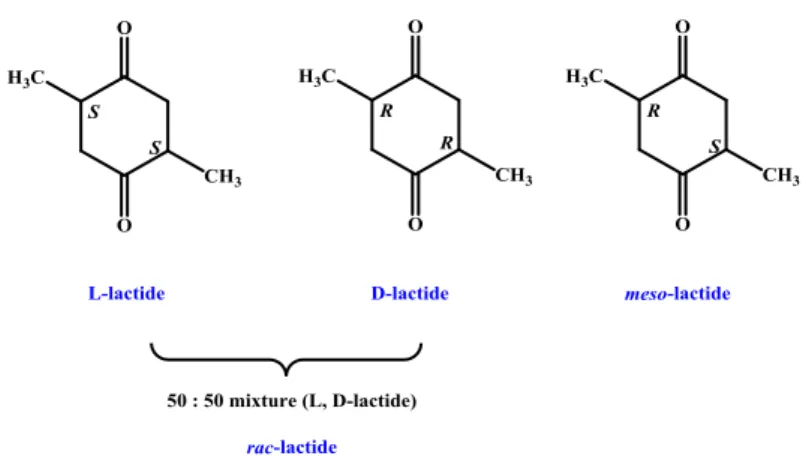
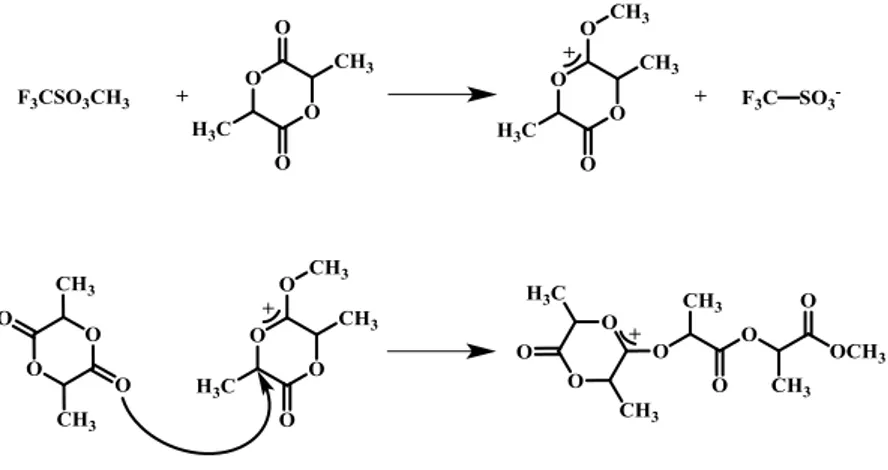
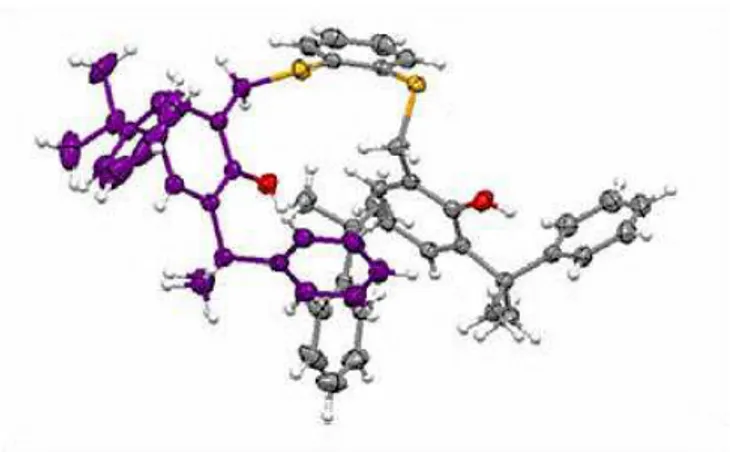
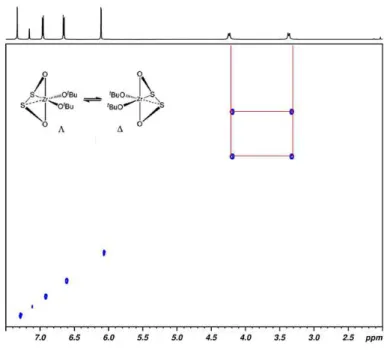
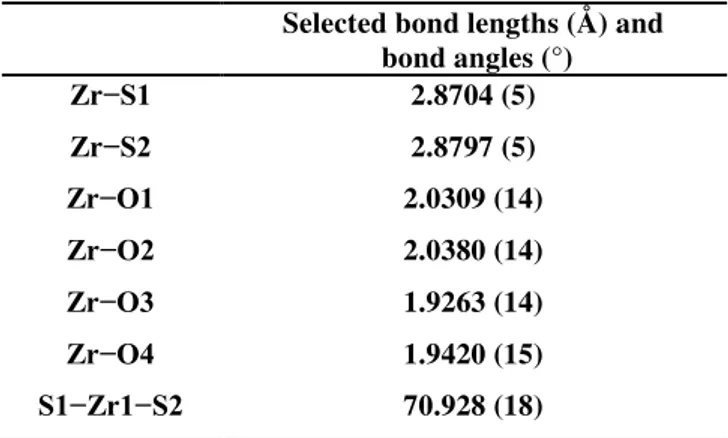
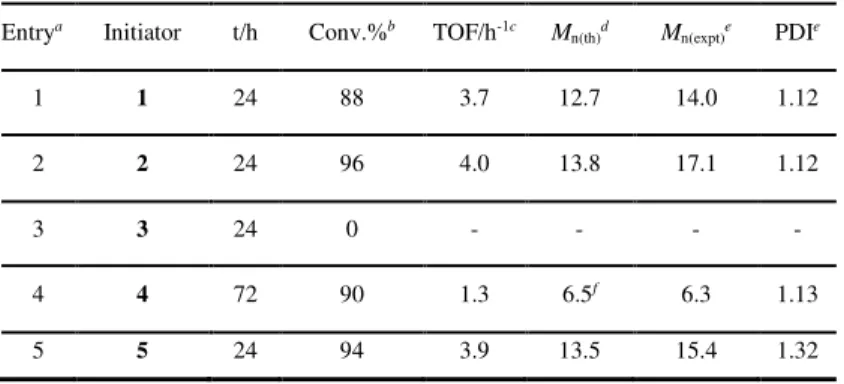
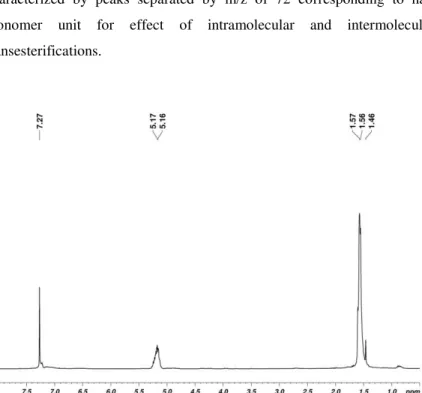
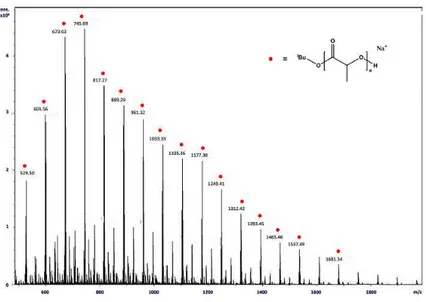
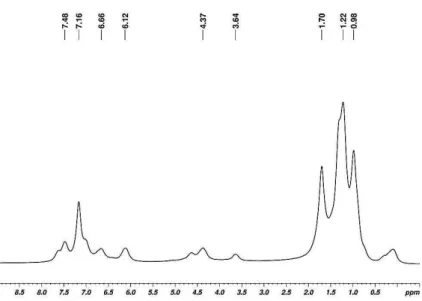
![Table 3.3.1. Ethylene polymerization with complexes 6-8/MMAO Entry a Precatalyst [Al]/[M] Yield](https://thumb-eu.123doks.com/thumbv2/123dokorg/7206326.76106/90.616.79.531.399.560/table-ethylene-polymerization-complexes-mmao-entry-precatalyst-yield.webp)